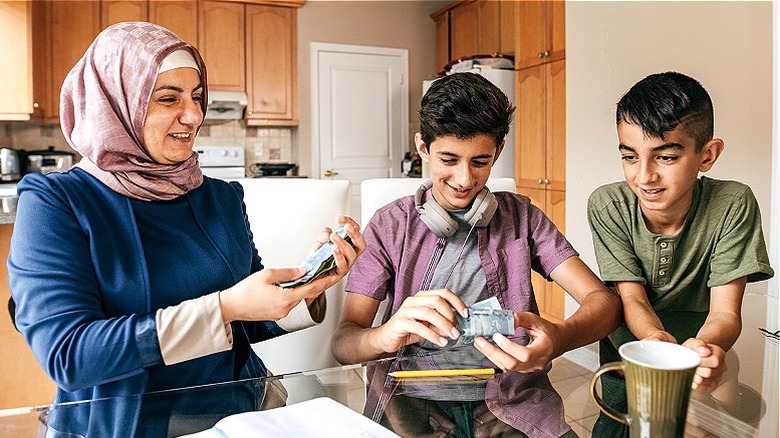How Much Allowance Should You Give Your Kids?
You're a good kid. You get all your homework done and keep your grades up. When Mom and Dad hand down a list of chores, you do your share without complaining. You don't pitch fits in the store, you don't pick fights with the neighbor kids, and you don't abuse your screen privileges. With all that good behavior, you're entitled to some spending money, right? And it only follows that, if you stay good, that allowance should grow. How big should it grow? Bigger — just bigger than it is, thank you.
Such is the logic of many of us when we were young, restless, and financially illiterate. Some have wondered if having pocket money doesn't mean as much to kids growing up in a world of one-click shopping and Amazon delivery. But physical toy stores still exist, allowances can be made digital, and the childhood joy in being able to buy something on your own hasn't lost its luster.
However they get it, many kids won't consider their allowance beyond whether they get it or not — and whether it can pay for what they want. It's for parents to puzzle over whether they should give their children an allowance at all, how much they should give, and in what form. But for any adults struggling with how to introduce their young ones to the world of personal finance, there are some basic rules of thumb that can be relied on.
The recommended allowance is $1 to $2 per week by age
The digital age hasn't deterred most Americans from paying an allowance. Seventy-nine percent of U.S. parents still give one to their kids, according to T. Rowe Price's 14th Annual Parents, Kids & Money Survey, with a mean allowance of $19.39 a week. A weekly allowance is the recommended pay period by financial and educational experts, too, providing a regular payment schedule that can still encourage kids to think about how much to spend and how much to save. But the things that a 5-year-old might want to spend and save for probably don't demand as much money as the things a 10-year-old may want, and both probably don't want anything as expensive as a 16-year-old could conceivably have access to. So how much allowance to pay at what age?
A generally accepted pay scheme is to offer kids $1 to $2 a week times how old they are. And so, a 10-year-old would get $10 or $20 every week, with an annual increase at each birthday. A variant on the same plan would pay $1 a week by age up to a certain point — say, the child's 13th birthday — and then move them to the $2 a week by age bracket. (See which states require financial literacy in high school.)
Paying by the chore has its pluses and its minuses
A regular allowance has its benefits. With an allowance every week, kids can learn about how to manage a regular income, how to spend some, save some, and share some. However, many parents tie getting an allowance to doing chores around the house. It's a way to teach the value of work and encourage kids to help out the family. It also turns withholding allowance into a reprimand for not staying on top of promised chores.
But there are problems with this way of handling an allowance. Kids might learn to use the system, arguing for "raises," or that certain chores deserve more money. That may not be a bad skill to learn, but if the kids have enough money for a given week, they may also decide to forgo chores altogether. Losing out on the money that represents is a lesson of a sort, but it also can disrupt learning to make regular, sound decisions about your money. Expert opinion is that it's simpler to have an allowance paid out because a child is part of the family, not for any specific behavior.
If you do want to use money to help teach kids about hard work, another option is to offer them commissions on top of their weekly allowance. Besides a weekly allowance, kids can earn extra cash through their chores — but only if they do them. It's further recommended that chores be split into categories: those that can be used for commissions, and those that are just part of being a family member.


